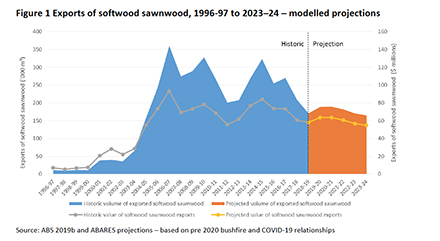A framework for developing medium term projections of traded wood products is a recent report released by ABARES that presents a proof of concept modelling exercise, reporting medium-term projections of the volume and value of trade in wood products based on a set of nested, historical relationships between wood product categories. Source: Timberbiz
Forest and Wood Products Australia (FWPA) commissioned ABARES to establish the modelling capability presented in this report, with the understanding that trade projections can be used to assist industry make better decisions and can assist governments in formulating policy.
The traded products selected for analysis are exports of sawnwood, roundwood, woodchips and builders’ joinery; and imports of sawnwood, plywood, builders’ joinery and mouldings. These products represented 43% of total Australian trade in wood products in 2018-19 and were selected through consultation with FWPA.
ABARES used a nested modelling approach to estimate imports and exports of forest products. A nested approach was chosen to best account for the interlinkages between trade in different wood products.
Exports of related products (namely sawnwood, roundwood and woodchips) are jointly projected by linking a series of simple econometric models and arithmetic equations (identities). The nested approach allows for the impact of many variables to be included while keeping the individual models small.
While there are limitations with a nested approach compared with structural models, small sample sizes required a more simplified approach. The remaining products (plywood, mouldings, and builders’ joinery) are projected independently.
The trade forecasts presented in this report, as well as the modelling approach are subject to several caveats. The most important caveat is that the models are based on historical data and relationships, up to the 2018-19 financial year. Significant deviations from observed history post 2018-19 are expected to result in deviations from the projected outcomes.
For example, the projections presented in this study do not reflect recent domestic and international events, including the 2019–20 bushfire season and COVID-19 pandemic. The bushfires are likely to have significant impacts on harvesting decisions in eastern Australia, and the flow on effects of COVID-19 are expected to lead to reduced domestic and international demand for some products.
This highlights how models are a useful base for medium term projections of trade outcomes, but that they should not be considered the last step in a projection task.
Importantly, modelled projections should also be revised or constrained to reflect wider domestic and international events. In future work associated with the framework, ABARES will integrate a number of features that allow for more readily updated and revised projection methodologies to better incorporate the impact of such events.
Download the full report A framework for developing medium term projections of traded wood products https://daff.ent.sirsidynix.net.au/client/en_AU/search/asset/1030581/0






